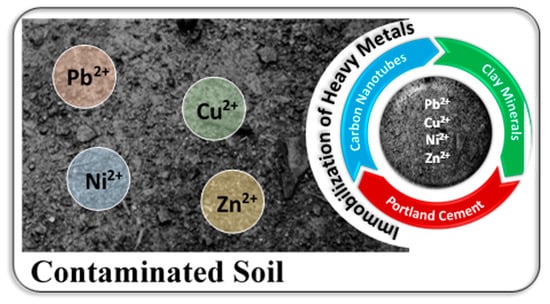Immobilization of Heavy Metals in Contaminated Soils—Performance Assessment in Conditions Similar to a Real Scenario
Abstract
1. Introduction
2. Materials and Experimental Procedures
2.1. Materials
2.2. Experimental Procedures
2.2.1. Adsorption Tests
- Adsorption tests with soil alone contaminated with the heavy metals (reference test) with the objective to evaluate the adsorption capacity of the soil particles by themselves to be used as reference for the remaining studies;
- Adsorption tests using a suspension of MWCNTs or montmorillonite (applied independently) dispersed in an aqueous solution of heavy metals, and pre-treated with ultrasounds and surfactant, with the objective to evaluate the adsorption capacity of these additives by themselves;
- Adsorption tests using soil contaminated with heavy metals combined with carbon nanotubes or clay mineral (montmorillonite), and pre-treated with ultrasounds and surfactant, with the objective to evaluate the benefits in the adsorption capacity of using the two dual systems (soil + MWCNTs or soil + montmorillonite).
2.2.2. Percolation Tests
2.2.3. Leaching Tests
3. Results and Discussion
3.1. Adsorption Tests
3.1.1. Addition of MWCNTs
3.1.2. Addition of Montmorillonite
3.2. Percolation Tests
3.2.1. Addition of MWCNTs
3.2.2. Addition of Montmorillonite
3.2.3. Portland Cement
3.3. Leaching Tests
4. Conclusions
Supplementary Materials
Author Contributions
Funding
Acknowledgments
Conflicts of Interest
Abbreviations
| C | concentration [mg/L] |
| Ca2+ | calcium ion |
| CNTs | carbon nanotubes |
| CSH | calcium silicate hydrated |
| Cu2+ | copper ion |
| G | specific gravity |
| M2+ | heavy metal ion |
| MWCNTs | multi-walled carbon nanotubes |
| Ni2+ | nickel ion |
| OM | organic matter |
| Pb2+ | lead ion |
| S/S | solidification/stabilization |
| SDBS | sodium dodecylbenzenesulfonate |
| SWCNTs | single-walled carbon nanotubes |
| w | natural water content |
| Zn2+ | zinc ion |
References
- Alloway, B.J. Sources of Heavy Metals and Metalloids in Soils. In Heavy Metals in Soils: Trace Metals and Metalloids in Soils and Their Bioavailability; Springer: New York, NY, USA, 2013; pp. 11–50. [Google Scholar]
- Liu, J.; Zha, F.; Xu, L.; Yang, C.; Chu, C.; Tan, X. Effect of chloride attack on strength and leaching properties of solidified/stabilized heavy metal contaminated soils. Eng. Geol. 2018, 246, 28–35. [Google Scholar] [CrossRef]
- Odigie, K.O.; Flegal, A.R. Trace metal inventories and lead isotopic composition chronicle a forest fire’s remobilization of industrial contaminants deposited in the Angeles National Forest. PLoS ONE 2014, 9, 52–61. [Google Scholar] [CrossRef] [PubMed]
- Li, Z.; Huang, B.; Huang, J.-Q.; Chen, G.-Q.; Xiong, W.-P.; Nie, X.-D.; Ma, W.-M.; Zeng, G.-M. Influence of different phosphates on adsorption and leaching of Cu and Zn in red soil. Trans. Nonferrous Metals Soc. China 2016, 26, 536–543. [Google Scholar] [CrossRef]
- Mulligan, C.N.; Yong, R.N.; Gibbs, B.F. Remediation technologies for metal-contaminated soils and groundwater: An evaluation. Eng. Geol. 2001, 60, 193–207. [Google Scholar] [CrossRef]
- Wuana, R.; Okieimen, F. Heavy Metals in Contaminated Soils: A Review of Sources, Chemistry, Risks and Best Available Strategies for Remediation. ISRN Ecol. 2011, 2011, 402647. [Google Scholar] [CrossRef]
- Yao, Q.; Wang, X.; Jian, H.; Chen, H.; Yu, Z. Characterization of the Particle Size Fraction associated with Heavy Metals in Suspended Sediments of the Yellow River. Int. J. Environ. Res. Public Health 2015, 12, 6725–6744. [Google Scholar] [CrossRef] [PubMed]
- Stevenson, F.J. Humus Chemistry: Genesis, Composition, Reactions, 2nd ed.; John Wiley: New York, NY, USA, 1997. [Google Scholar]
- Scanferla, P.; Ferrari, G.; Pellay, R.; Volpi Ghirardini, A.; Zanetto, G.; Libralato, G. An innovative stabilization/solidification treatment for contaminated soil remediation: Demonstration project results. J. Soils Sediments 2009, 9, 229–236. [Google Scholar] [CrossRef]
- Liu, Y.; Tang, Y.; Zhong, G.; Zeng, H. A comparison study on heavy metal/metalloid stabilization in Maozhou River sediment by five types of amendments. J. Soils Sediments 2019. [Google Scholar] [CrossRef]
- US EPA. Treatment Technologies for Site Cleanup: Annual Status Report, 11th ed.; EPA-542-R-03-009; US EPA: Washington, DC, USA, 2004.
- US EPA. Solidification; U.S. Environmental Protection Agency: Washington, DC, USA, 2019. Available online: https://clu-in.org/techfocus/default.focus/sec/Solidification/cat/Overview/ (accessed on 19 February 2019).
- Al-Tabbaa, A.; Stegemann, J. Stabilisation/Solidification Treatment and Remediation. In Proceedings of the International Conference on Stabilization/Solidification Treatment and Remediation, Cambridge, UK, 12–13 April 2005; 485p. [Google Scholar]
- Ikegami, M.; Ichiba, T.; Ohishi, K.; Terashi, M. Longterm properties of cement treated soil 20 years after construction. In Proceedings of the 16th International Conference on Soil Mechanics and Geotechnical Engineering, Osaka, Japan, 12–16 September 2005. [Google Scholar]
- Kumpiene, J.; Lagerkvist, A.; Maurice, C. Stabilization of As, Cr, Cu, Pb and Zn in soil using amendments—A review. Waste Manag. 2008, 28, 215–225. [Google Scholar] [CrossRef]
- Mueller, N.C.; Nowack, B. Nanoparticles for remediation: Solving big problems with little particles. Elements 2010, 6, 395–400. [Google Scholar] [CrossRef]
- Wang, F.-H.; Zhao, B.; Zhang, F.; Gao, J.; Hao, H.-T.; Zhang, S. A novel heavy metal chelating agent sixthio guanidine acid for in situ remediation of soils contaminated with multielements: Its synthesis, solidification, biodegradability, and leachability. J. Soils Sediments 2016, 16, 371–381. [Google Scholar] [CrossRef]
- Ma, X.; Zheng, C.; Li, W.; Ai, S.; Zhang, Z.; Zhou, X.; Pang, C.; Chen, H.; Zhou, K.; Tang, M.; et al. Potential use of cotton for remediating heavy metal-polluted soils in southern China. J. Soils Sediments 2017, 17, 2866–2872. [Google Scholar] [CrossRef]
- Xia, W.Y.; Feng, Y.-S.; Jin, F.; Zhang, L.-M.; Du, Y.-J. Stabilization and solidification of a heavy metal contaminated site soil using a hydroxyapatite based binder. Construct. Build Mater. 2017, 156, 199–207. [Google Scholar] [CrossRef]
- Dai, Y.; Yuan, L.; Xu, X.; Zhao, L.; Cao, X. An integrated approach for simultaneous immobilization of lead in both contaminated soil and groundwater: Laboratory test and numerical modeling. J. Hazard. Mater. 2018, 342, 107–113. [Google Scholar] [CrossRef] [PubMed]
- Peng, W.; Li, X.; Xiao, S.; Fan, W. Review of remediation technologies for sediments contaminated by heavy metals. J. Soils Sediments 2018, 18, 1701–1719. [Google Scholar] [CrossRef]
- Khan, I.; Abbas, A.; Al-Amer, A.; Laoui, T.; Almarri, M.; Nasser, M.; Khraisheh, M.; Atieh, A. Heavy metal removal from aqueous solution by advanced carbon nanotubes: Critical review of adsorption applications. Sep. Purif. Technol. 2015, 157, 141–161. [Google Scholar]
- Evanoff, K.; Khan, J.; Balandin, A.; Magasinski, A.; Ready, W.; Fuller, T.; Yushin, G. Towards ultrathick battery electrodes: Aligned carbon nanotube-enabled architecture. Adv. Mater. 2012, 24, 533–537. [Google Scholar] [CrossRef]
- Dey, P.; Das, N. Carbon Nanotubes: It’s role in modern health care. Int. J. Pharm. Pharm. Sci. 2013, 5, 9–13. [Google Scholar]
- Beigbeder, A.; Degee, P.; Conlan, S.L.; Mutton, R.J.; Clare, A.S.; Pettitt, M.E.; Callow, M.E.; Callow, J.A.; Dubois, P. Preparation and characterisation of silicone-based coatings filled with carbon nanotubes and natural sepiolite and their application as marine fouling-release coatings. Biofouling 2008, 24, 291–302. [Google Scholar] [CrossRef]
- Thakur, V.K.; Thakur, M.K. The Use of Carbon Nanotubes in the Treatment of Water and Wastewater. In Chemical Functionalization of Carbon Nanomaterials: Chemistry and Applications; CRC Press: Boca Raton, FL, USA, 2015; pp. 705–719. [Google Scholar]
- Zhao, X.; Jia, Q.; Song, N.; Zhou, W.; Li, Y. Adsorption of Pb(II) from an aqueous solution by titanium dioxide/carbon nanotube nanocomposites: Kinetics, thermodynamics, and isotherms. J. Chem. Eng. Data 2010, 55, 4428–4433. [Google Scholar] [CrossRef]
- Li, Y.H.; Luan, Z.; Xiao, X.; Zhou, X.; Xu, C.; Wu, D.; Wei, B. Removal of Cu2+ ions from aqueous solutions by carbon nanotubes. Adsorpt. Sci. Technol. 2003, 21, 475–485. [Google Scholar] [CrossRef]
- Gadhave, A.; Waghmare, J. Removal of heavy metal ions from wastewater by Carbon Nanotubes (CNTs). Int. J. Chem. Sci. Appl. 2014, 5, 56–67. [Google Scholar]
- Yang, S.; Li, J.; Shao, D.; Hu, J.; Wang, X. Adsorption of Ni(II) on oxidized multi-walled carbon nanotubes: Effect of contact time, pH, foreign ions and PAA. J. Hazard. Mater. 2009, 166, 109–116. [Google Scholar] [CrossRef]
- Matos, M.P.S.R.; Correia, A.A.S.; Rasteiro, M.G. Application of carbon nanotubes to immobilize heavy metals in contaminated soils. J. Nanoparticle Res. 2017, 19, 126. [Google Scholar] [CrossRef]
- Datsyuk, V.; Landois, P.; Fitremann, J.; Peigney, A.; Galibert, A.M.; Soula, B.; Flahaut, E. Double-walled carbon nanotube dispersion via surfactant substitution. J. Mater. Chem. 2009, 19, 2729. [Google Scholar] [CrossRef]
- Rossell, M.D. Impact of sonication pretreatment on carbon nanotubes: A transmission electron microscopy study. Carbon 2013, 61, 404–411. [Google Scholar] [CrossRef]
- Rastogi, R.; Kaushal, R.; Tripathi, S.K.; Sharma, A.L.; Kaur, I.; Bharadwaj, L.M. Comparative study of carbon nanotube dispersion using surfactants. J. Colloid Interface Sci. 2008, 328, 421–428. [Google Scholar] [CrossRef]
- Figueiredo, D.T.R.; Correia, A.A.S.; Hunkeler, D.; Rasteiro, M.G. Surfactants for dispersion of carbon nanotubes applied in soil stabilization. Colloids Surf. A Physicochem. Eng. Asp. 2015, 480, 405–412. [Google Scholar] [CrossRef]
- Zhang, G.; Lin, Y.; Wang, M. Remediation of copper polluted red soils with clay materials. J. Environ. Sci. 2011, 23, 461–467. [Google Scholar] [CrossRef]
- Alvarez-Ayuso, E.; García-Sánchez, A. Sepiolite as a feasible soil additive for the immobilization of cadmium and zinc. Sci. Total Environ. 2003, 305, 1–12. [Google Scholar] [CrossRef]
- Garcia-Sanches, A.; Alvarez-Ayuso, E.; Rodrigues-Martin, F. Sorption of As(V) by some oxyhydroxides and clay minerals. Application to its immobilization in two polluted mining soils. Clay Miner. 2012, 37, 187–194. [Google Scholar] [CrossRef]
- Aydinalp, C.; Marinova, S. Distribution and forms of heavy metals in some agricultural soils. Pol. J. Environ. Stud. 2003, 12, 629–633. [Google Scholar]
- Korte, N.E.; Skopp, J.; Fuller, W.H.; Niebla, E.E.; Alesii, B.A. Trace element movement in soils: Influence of soil physical and chemical properties. Soil Sci. 1976, 122, 350–359. [Google Scholar] [CrossRef]
- Malakul, P.; Srinivasan, K.R.; Wang, H.Y. Metal Adsorption and Desorption Characteristics of Surfactant-Modified Clay Complexes. Ind. Eng. Chem. Res. 1998, 37, 4296–4301. [Google Scholar] [CrossRef]
- Mao, X.; Jiang, R.; Xiao, W.; Yu, J. Use of surfactants for the remediation of contaminated soils: A review. J. Hazard. Mater. 2015, 285, 419–435. [Google Scholar] [CrossRef]
- Mulligan, C.N.; Yong, R.N.; Gibbs, B.F. Surfactant-enhanced remediation of contaminated soil: A review. Eng. Geol. 2001, 60, 371–380. [Google Scholar] [CrossRef]
- Zhao, G.; Wu, X.-L.; Tan, X.; Wang, X. Sorption of Heavy Metal Ions from Aqueous Solutions: A Review. Open Colloid Sci. J. 2011, 4, 19–31. [Google Scholar] [CrossRef]
- Akhter, H.; Cartledge, F.K.; Miller, J.; McLearn, M. Treatment of Arsenic-Contaminated Soils I: Soil Characterization. J. Environ. Eng. 2000, 126, 999–1003. [Google Scholar] [CrossRef]
- Dermatas, D.; Meng, X. Utilization of fly ash for stabilization/solidification of heavy metal contaminated soils. Eng. Geol. 2003, 70, 377–394. [Google Scholar] [CrossRef]
- Lei, W.; Dong-Wan, C.; Daniel, C.W.T.; Xinde, C.; Deyi, H.; Zhengtao, S.; Daniel, S.A.; Yong, S.O.; Chi, S.P. Green remediation of As and Pb contaminated soil using cement-free clay-based stabilization/solidification. Environ. Int. 2019, 126, 336–345. [Google Scholar]
- Li, W.; Ni, P.; Yi, Y. Comparison of reactive magnesia, quick lime, and ordinary Portland cement for stabilization/solidification of heavy metal-contaminated soils. Sci. Total Environ. 2019, 671, 741–753. [Google Scholar] [CrossRef]
- Voigt, D.E.; Brantley, S.L.; Hennet, R.J.-C. Chemical fixation of arsenic in contaminated soils. Appl. Geochem. 1996, 11, 633–643. [Google Scholar] [CrossRef]
- Vaddoriya, K. Immobilization of heavy metals using solidification/stabilization treatment: A review. Int. J. Av. Res. Innov. Ideas Educ. 2016, 2, 49–53. [Google Scholar]
- Du, Y.J. An Overview of Stabilization/Solidification Technique for Heavy Metals Contaminated Soils. In Advances in Environmental Geotechnics; Springer: Berlin/Heidelberg, Germany, 2010; pp. 760–766. [Google Scholar]
- Wayne, S.A.; Tresouthick, S.W.; Presbury, B.W. Solidification and Stabilization of Wastes Using Portland Cement; Portland Cement Association: Skokie, IL, USA, 1991. [Google Scholar]
- Correia, A.A.S. Applicability of Deep Mixing Technique to the Soft Soil of Baixo Mondego. Ph.D. Dissertation, University of Coimbra, Coimbra, Portugal, 2011. [Google Scholar]
- Kitazume, M.; Terashi, M. The Deep Mixing Method; CRC Press: Leiden, The Netherlands, 2013. [Google Scholar]
- Goyal, M.K.; Chauhan, A. Environmental Pollution Remediation through Solidification/Fixation of Heavy Metal Ions in Portland Cement. Environ. Anal. Toxicol. 2015, 5, 1. [Google Scholar]
- Coelho, P. Geotechnical Caracterization of Soft Soils: Case Study of Quinta da Foja (Baixo Mondego). Master’s Thesis, University of Coimbra, Coimbra, Portugal, 2000. [Google Scholar]
- ASTM D2487. Standard Classification of Soils for Engineering Purposes (Unified Soil Classification System); ASTM: West Conshohoken, PA, USA, 1998. [Google Scholar]
- Costa, C.; Jesus-Rydin, C. Site investigation on heavy metals contaminated ground in Estarreja—Portugal. Eng. Geol. 2001, 60, 39–47. [Google Scholar] [CrossRef]
- Inácio, M.; Pereira, V.; Pinto, M. The Soil Geochemical Atlas of Portugal: Overview and applications. J. Geochem. Explor. 2008, 98, 22–33. [Google Scholar] [CrossRef]
- Ministry of the Environment. Soil, Groundwater and Sediment Standards for the Use Under. Part XV.1 of the Environmental Protection Act; Ministry of the Environment: Toronto, ON, USA, 2011.
- Malvern Instruments. Zetasizer Nano Series User Manual. 2004. Available online: https://vdocuments.mx/zetasizer-nano-user-manual-man0317-11-5654990fbc053.html (accessed on 31 July 2016).
- NEN 7345. Leaching Characteristics of Moulded or Monolithic Building and Waste Materials—Determination of Leaching of Inorganic Components with the Diffusion Test; Nederlands Normalisatie Instituut: Delft, The Nederlands, 2004. [Google Scholar]
- Gao, Z.; Bandosz, T.; Zhao, Z.; Han, M.; Qiu, J. Investigation of factors affecting adsorption of transition metals on oxidized carbon nanotubes. J. Hazard. Mater. 2009, 167, 357–365. [Google Scholar] [CrossRef]
- Kinraide, T.B.; Yermiyahu, U. A scale of metal ion binding strengths correlating with ionic charge, Pauling electronegativity, toxicity, and other physiological effects. J. Inorg. Biochem. 2007, 101, 1201–1213. [Google Scholar] [CrossRef]
- Gomes, P.; Fontes, M. Selectivity Sequence and Competitive Adsorption of Heavy Metals by Brazilian Soils. Soil Sci. Soc. Am. J. 2001, 65, 1115–1121. [Google Scholar] [CrossRef]
- Correia, A.A.S.; Rasteiro, M.G. Nanotechnology Applied to Chemical Soil Stabilization. Procedia Eng. 2016, 143, 1252–1259. [Google Scholar] [CrossRef]
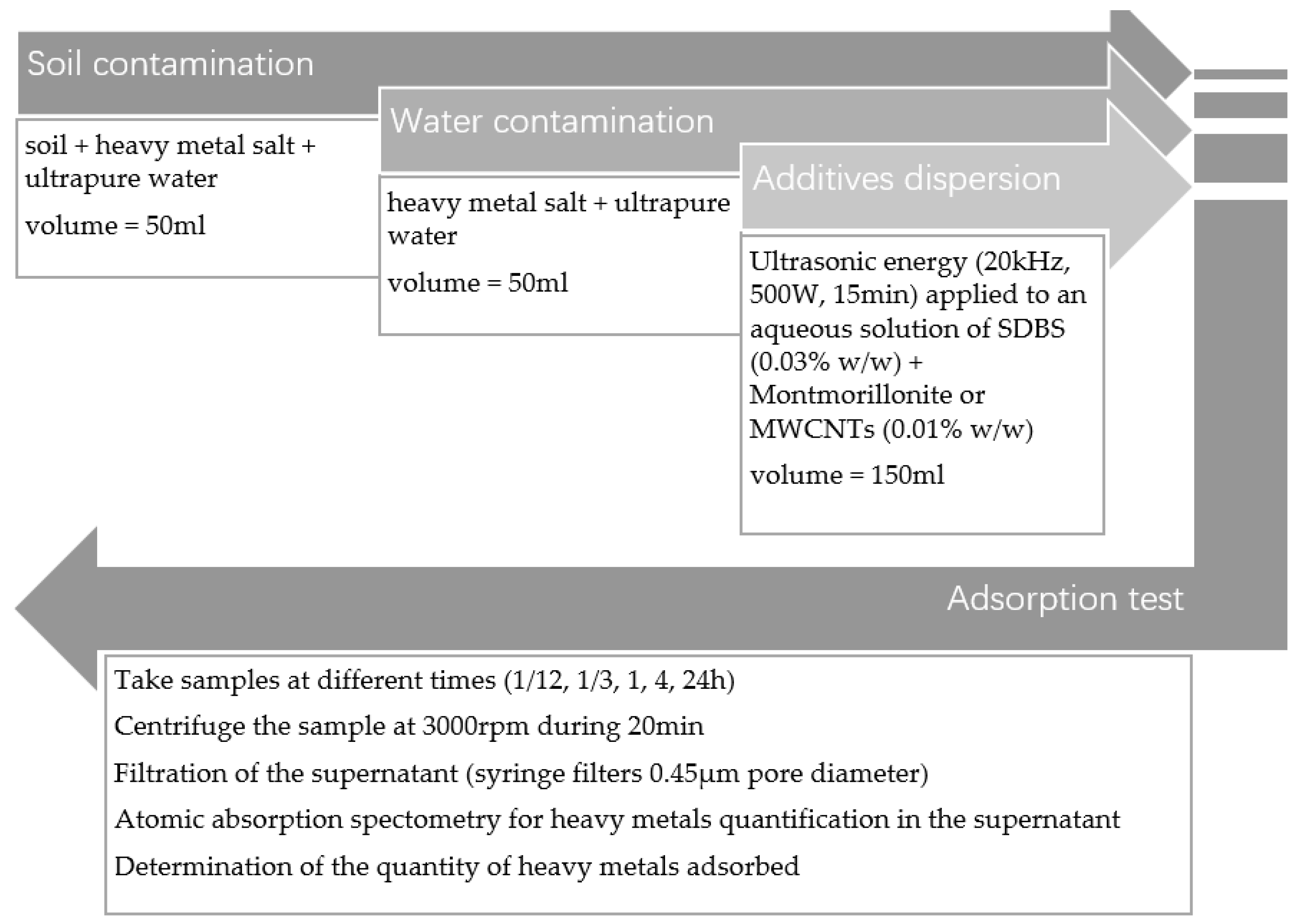

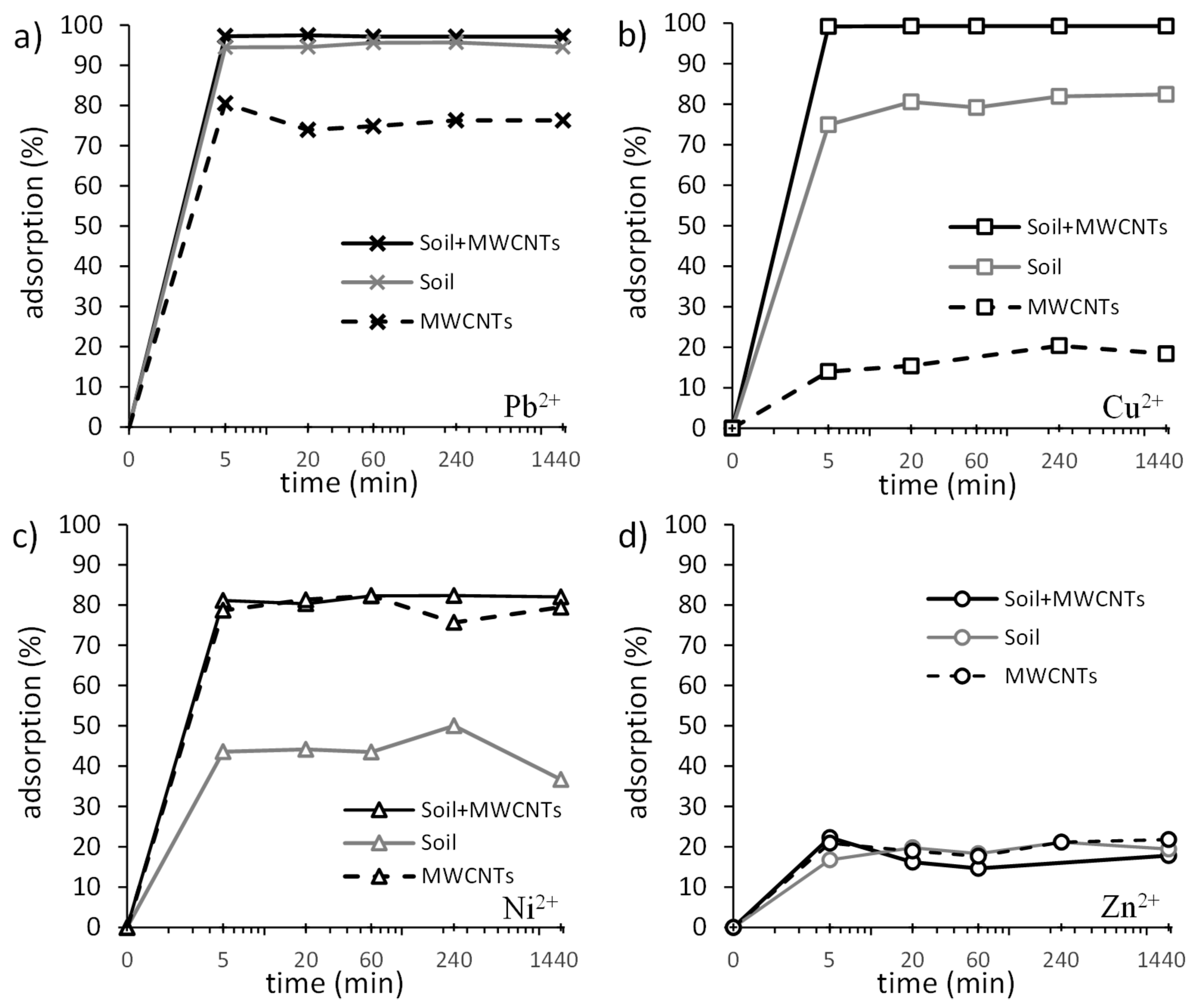
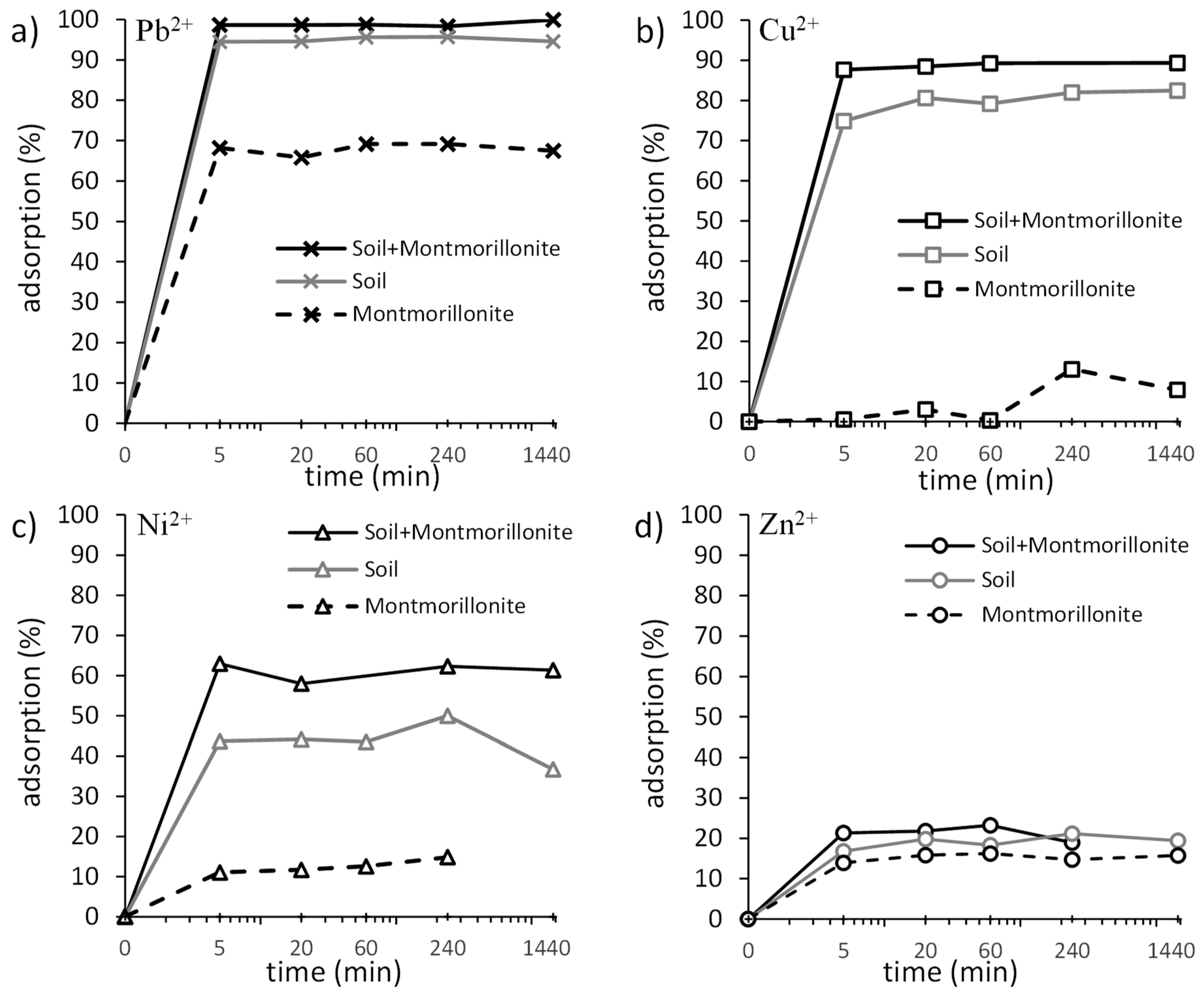


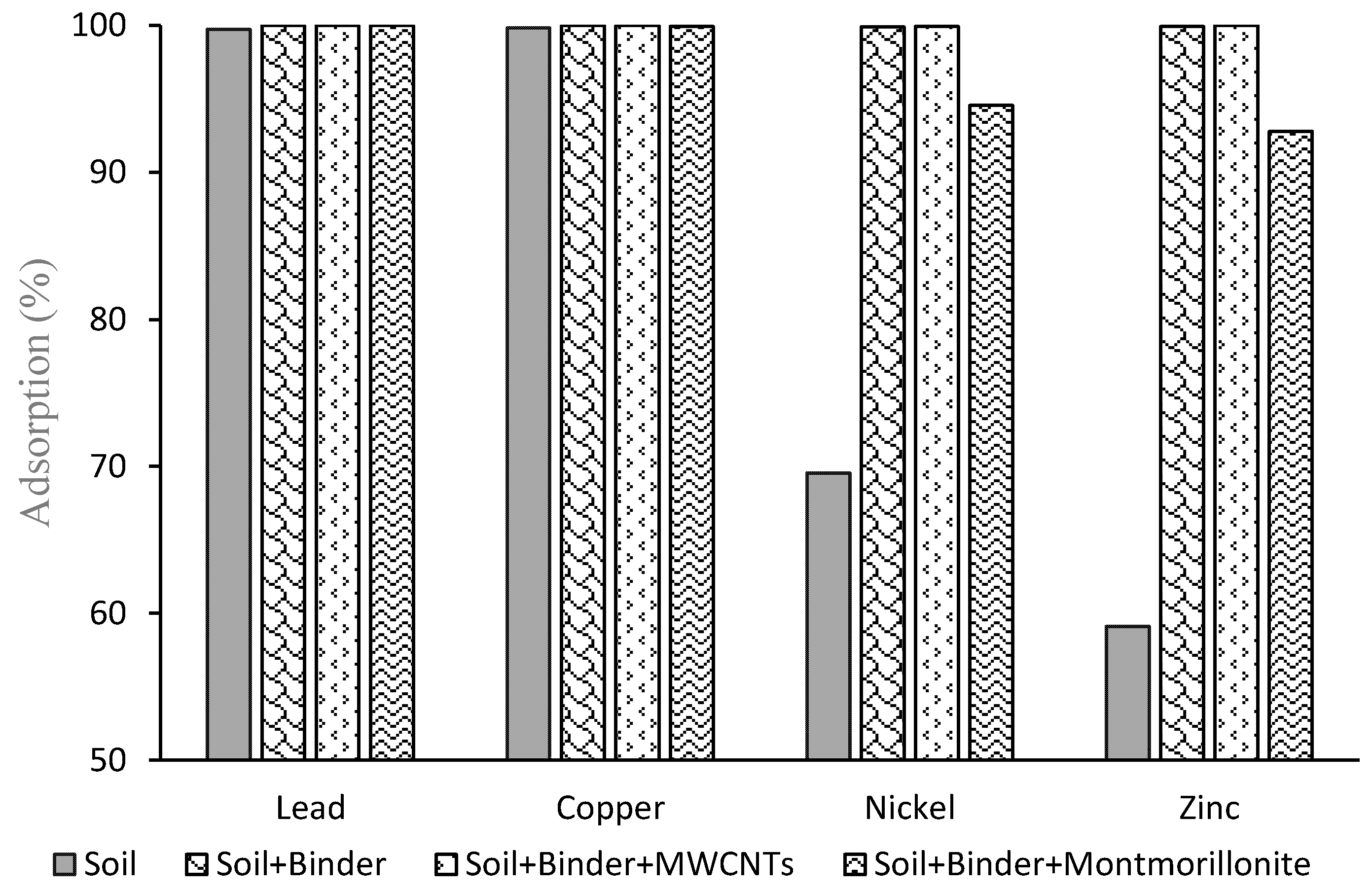
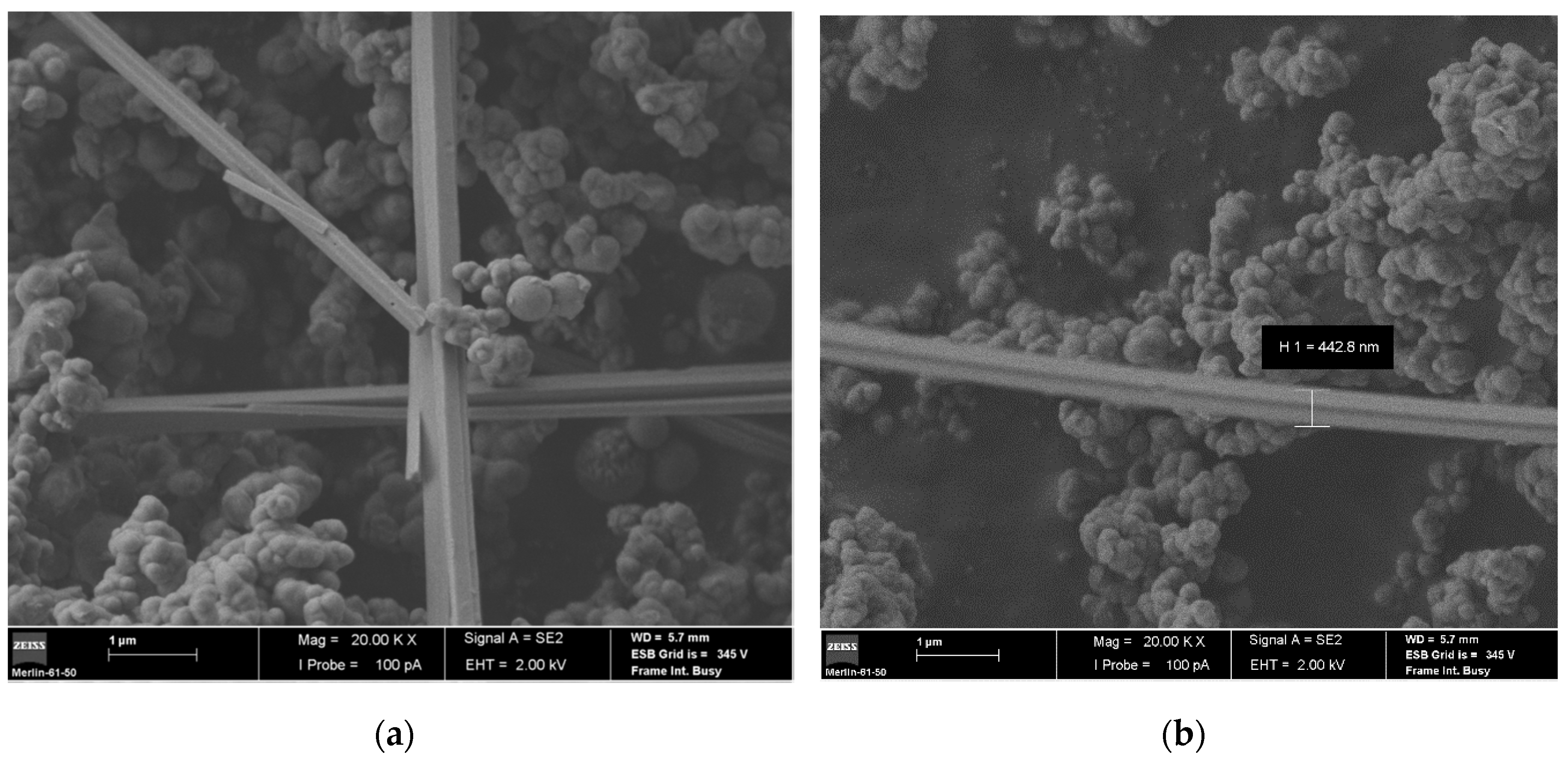
| Soil Characteristics | ||
|---|---|---|
| Grain size distribution | Clay (%) (w/w) | 21 |
| Silt (%) (w/w) | 59 | |
| Sand (%) (w/w) | 20 | |
| Specific gravity | G (-) | 2.6 |
| Natural water content | w (%) (w/w) | 80.9 |
| Liquid limit | wL (%) | 54.1 (a) |
| Plastic limit | wP (%) | 39.8 |
| Organic matter content | OM (%) (w/w) | 7.4 |
| pH | pH (-) | 5.4 |
| Soil classification USCS (b) | (-) | OH |
| Heavy Metal | The Soil Geochemical Atlas of Portugal [59] | Ontario Soil Quality Guidelines [60] |
|---|---|---|
| Maximum Value Registered (mg/kg) | Reference Values (mg/kg) | |
| Lead | 585 | 120 |
| Copper | 245 | 230 |
| Nickel | 880 | 270 |
| Zinc | 589 | 340 |
| Components | CaO | SiO2 | Al2O3 | Fe2O3 | MgO | SO3 |
|---|---|---|---|---|---|---|
| % (w/w) | 63 | 19 | 5 | 3 | 3 | 3 |
| Components | Na2O | MgO | Al2O3 | SiO2 | P2O5 | SO3 | K2O | CaO | TiO2 | Mn3O4 | Fe2O3 | ||||
|---|---|---|---|---|---|---|---|---|---|---|---|---|---|---|---|
| % (w/w) | 2.03 | 2.26 | 19.16 | 58.6 | 0.05 | 0.9 | 0.55 | 1.26 | 0.17 | 0.02 | 3.69 | ||||
| Minerals | Dioctahedral smectite | Quartz | Illite | Opal | Potassium feldspar | ||||||||||
| % | 85–90 | 5 | 2 | 2 | trace | ||||||||||
Publisher’s Note: MDPI stays neutral with regard to jurisdictional claims in published maps and institutional affiliations. |
© 2020 by the authors. Licensee MDPI, Basel, Switzerland. This article is an open access article distributed under the terms and conditions of the Creative Commons Attribution (CC BY) license (http://creativecommons.org/licenses/by/4.0/).
Share and Cite
Correia, A.A.S.; Matos, M.P.S.R.; Gomes, A.R.; Rasteiro, M.G. Immobilization of Heavy Metals in Contaminated Soils—Performance Assessment in Conditions Similar to a Real Scenario. Appl. Sci. 2020, 10, 7950. https://doi.org/10.3390/app10227950
Correia AAS, Matos MPSR, Gomes AR, Rasteiro MG. Immobilization of Heavy Metals in Contaminated Soils—Performance Assessment in Conditions Similar to a Real Scenario. Applied Sciences. 2020; 10(22):7950. https://doi.org/10.3390/app10227950
Chicago/Turabian StyleCorreia, Antonio A. S., Martim P. S. R. Matos, Ana R. Gomes, and Maria G. Rasteiro. 2020. "Immobilization of Heavy Metals in Contaminated Soils—Performance Assessment in Conditions Similar to a Real Scenario" Applied Sciences 10, no. 22: 7950. https://doi.org/10.3390/app10227950
APA StyleCorreia, A. A. S., Matos, M. P. S. R., Gomes, A. R., & Rasteiro, M. G. (2020). Immobilization of Heavy Metals in Contaminated Soils—Performance Assessment in Conditions Similar to a Real Scenario. Applied Sciences, 10(22), 7950. https://doi.org/10.3390/app10227950






